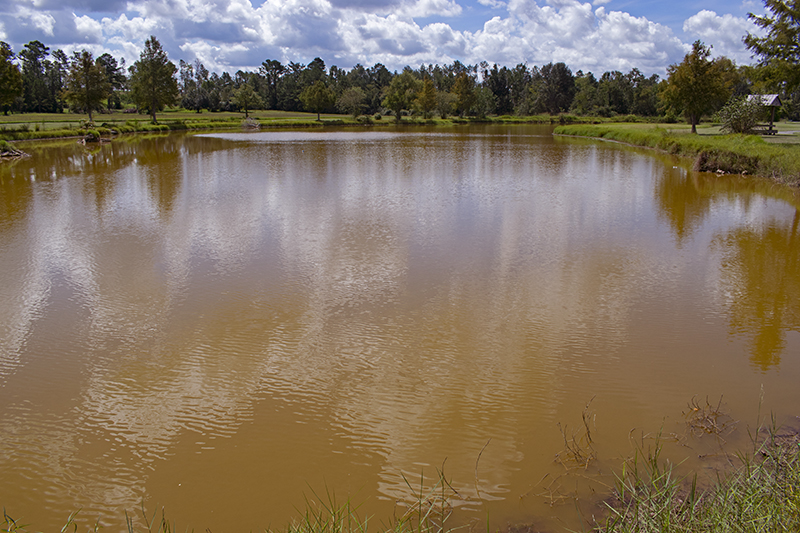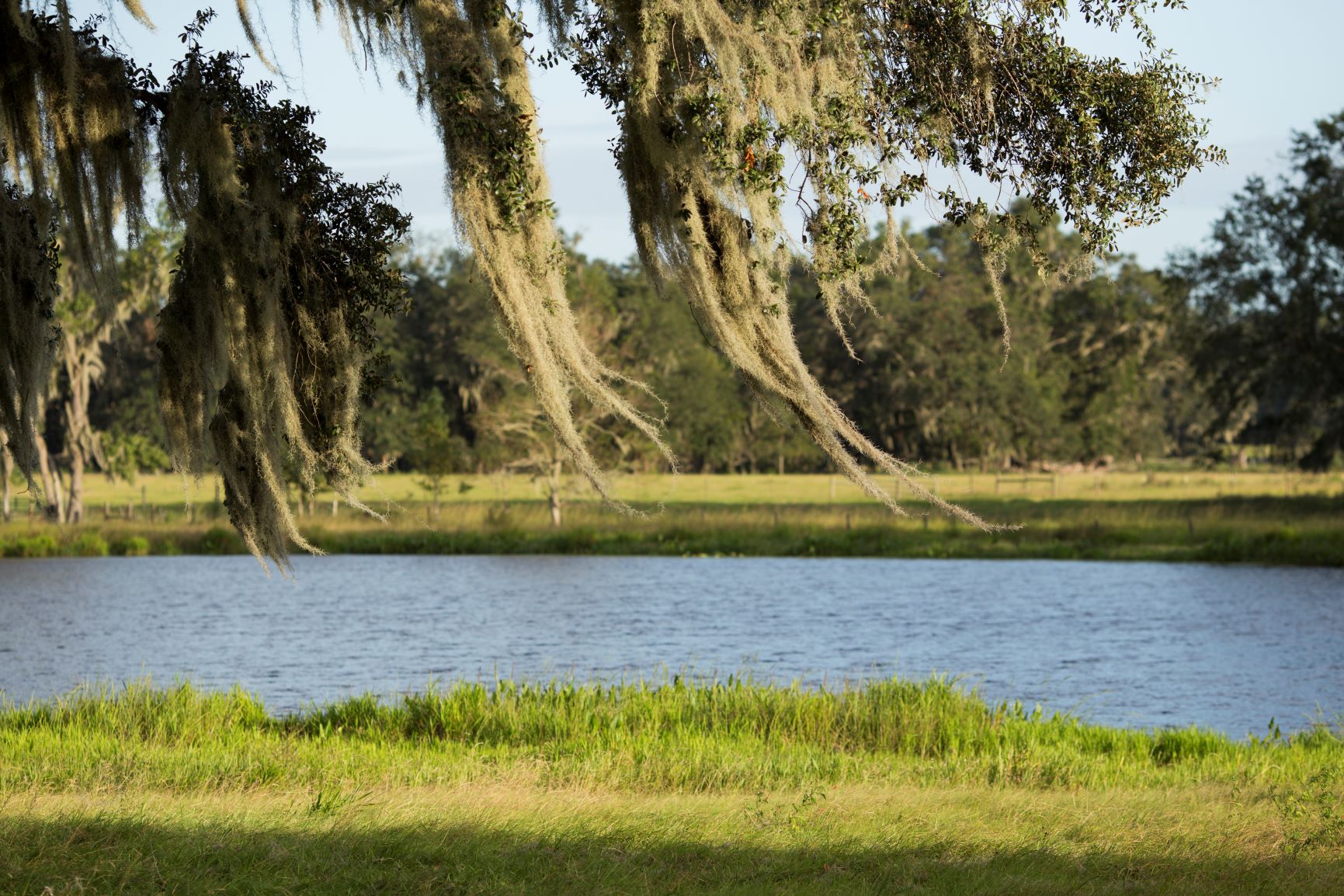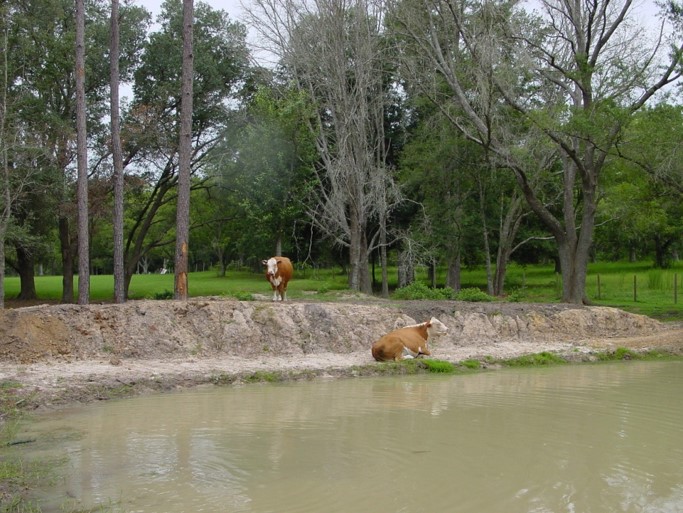
Muddy water can be a problem in ponds like this one in Jackson County. The first step is to try to determine the source of the problem. It could be from soil erosion, livestock traffic, or even bottom-feeding fish. Credit: Doug Mayo, UF/IFAS
–
Muddy water can be a problem in ponds across the Florida Panhandle. Not only is it unattractive, but it can be detrimental to life in a pond. Muddy or cloudy water reduces the amount of sunlight that enters a pond. This decreases the quantity of available fish food since the algae and plants that form the base of the food chain need sunlight to grow. Reduced visibility in the water also makes it hard for predatory fish like largemouth bass to catch prey.
What causes muddy water?
The first step towards clearing a muddy pond is to determine what is causing the problem. Muddiness is due to sediment suspended in the water column. The most common cause of this is soil erosion. Other factors also reduce water clarity, but look different from muddy water. High concentrations of microscopic algae can make a pond turn pea green, and dissolved organic matter (like when you boil tea leaves) can give the water a dark color.
What can you do to clear a muddy pond?
Soil erosion, as wind and runoff from rain send sediment into a pond, is the most common culprit of muddy water. This can be a particularly severe problem around newly dug ponds. Planting grasses and other vegetation around your pond, and minimizing the amount of bare soil on nearby fields by planting cover crops is the best way to reduce erosion. Wind not only blows exposed soil into ponds, but it can also churn up sediment in shallow areas, so planting windbreaks (trees, shrubs or other tall vegetation) where this is a problem is important.

Vegetated shorelines prevent soil erosion and help keep pond water clear. Photo credit: T. Jones, UF/IFAS.
–
Livestock that use the pond for water and cooling off erode the shoreline and re-suspend fine sediment as they wade. Fencing the entire pond and providing an alternative water supply will remove the problem. If this is not possible on your property, fencing off most of the pond and providing a smaller access area is an alternative option. Adding something like gravel to the shoreline of the defined access area will further reduce erosion.

Cattle erode pond shorelines and re-suspend fine sediment as they wade. Photo credit: C. Cichra, UF/IFAS.
–
Large numbers of catfish in a pond stir up bottom sediments, and this will not change unless numbers decrease. Nuisance bottom-feeding fish like common carp and bullheads will do this as well. If you want to eliminate them, removal strategies for unwanted fish are detailed in the UF/IFAS EDIS publication “Managing Florida Ponds for Fishing.”
If you’ve addressed the issues listed above by reducing soil erosion and decreasing sediment re-suspension and your pond still does not clear up, then the issue is likely due to tiny suspended clay particles that are not settling out of the water column. You can test this by collecting the muddy water in a jar and letting it settle for at least 24 hours. If no settling occurs and the water stays muddy, then adding chemical amendments to your pond will help the clay particles settle out. But, if the water clears up and particles settle out, then you still need to address the underlying erosion or re-suspension problem on your property.
Chemical treatment to settle out suspended sediment
Agricultural gypsum and alum (aluminum sulfate) are common additives used to settle out suspended clay particles. A general recommendation in Florida is to broadcast 75-100 lbs. of ground gypsum or 5-15 lbs. of commercial alum crystals per acre foot of water (https://edis.ifas.ufl.edu/fa001). But, an effective dose and which product to use really depend on pond characteristics (water chemistry), the products available to you, and the capacity to apply them.
For specific information on using chemical amendments, Texas A&M’s publication “Water management: Clearing Cloudy and Muddy Water in Ponds and Lakes” explains the process in detail. The second half of the document (pages 7-14) is dedicated to how to determine which treatment is best for you, based on pond characteristics and how to calculate the recommended dose.
Cost share opportunities for erosion control on-farm
If you have soil erosion problems on your operation, the Florida Department of Agriculture’s Office of Ag Water Policy (FDACS OAWP) and the USDA’s Natural Resources Conservation Service (NRCS) have cost-share funds available to help you address soil erosion issues on farms. For more information on available cost-shares and funding deadlines, contact your local FDACS field staff and NRCS office. Contact information can be found at:
FDACS Office of Ag Water Policy: Field Staff
- What to Do if Sinkholes Open on Your Property - November 15, 2024
- Crop Farmers Implementing BMPs in the Chipola River Basin - May 24, 2024
- The Granberry Farm: Sustainably Managing a Cattle Ranch in the Chipola River Basin - January 5, 2024
